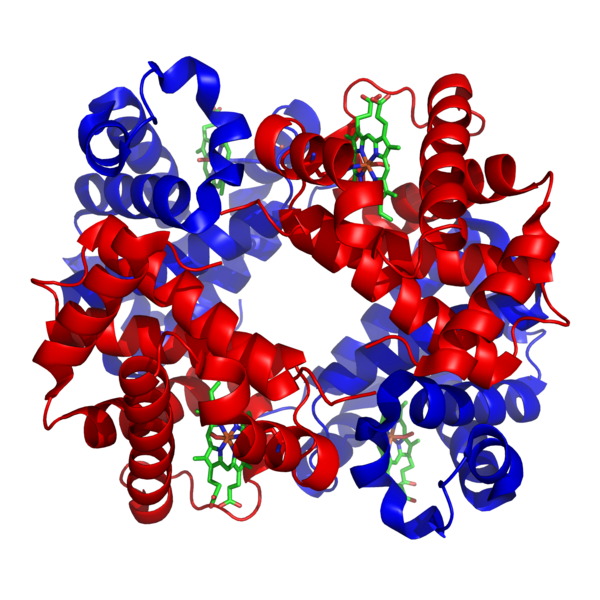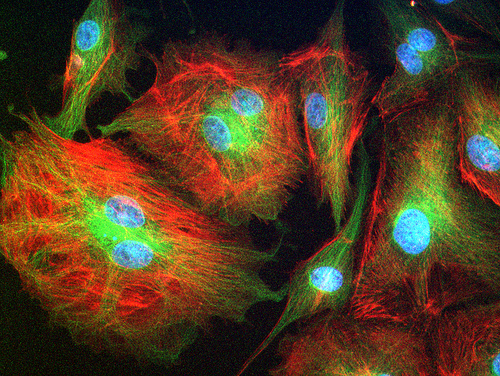3.7: Proteins - Types and Functions of Proteins
- Page ID
- 12698
\( \newcommand{\vecs}[1]{\overset { \scriptstyle \rightharpoonup} {\mathbf{#1}} } \)
\( \newcommand{\vecd}[1]{\overset{-\!-\!\rightharpoonup}{\vphantom{a}\smash {#1}}} \)
\( \newcommand{\id}{\mathrm{id}}\) \( \newcommand{\Span}{\mathrm{span}}\)
( \newcommand{\kernel}{\mathrm{null}\,}\) \( \newcommand{\range}{\mathrm{range}\,}\)
\( \newcommand{\RealPart}{\mathrm{Re}}\) \( \newcommand{\ImaginaryPart}{\mathrm{Im}}\)
\( \newcommand{\Argument}{\mathrm{Arg}}\) \( \newcommand{\norm}[1]{\| #1 \|}\)
\( \newcommand{\inner}[2]{\langle #1, #2 \rangle}\)
\( \newcommand{\Span}{\mathrm{span}}\)
\( \newcommand{\id}{\mathrm{id}}\)
\( \newcommand{\Span}{\mathrm{span}}\)
\( \newcommand{\kernel}{\mathrm{null}\,}\)
\( \newcommand{\range}{\mathrm{range}\,}\)
\( \newcommand{\RealPart}{\mathrm{Re}}\)
\( \newcommand{\ImaginaryPart}{\mathrm{Im}}\)
\( \newcommand{\Argument}{\mathrm{Arg}}\)
\( \newcommand{\norm}[1]{\| #1 \|}\)
\( \newcommand{\inner}[2]{\langle #1, #2 \rangle}\)
\( \newcommand{\Span}{\mathrm{span}}\) \( \newcommand{\AA}{\unicode[.8,0]{x212B}}\)
\( \newcommand{\vectorA}[1]{\vec{#1}} % arrow\)
\( \newcommand{\vectorAt}[1]{\vec{\text{#1}}} % arrow\)
\( \newcommand{\vectorB}[1]{\overset { \scriptstyle \rightharpoonup} {\mathbf{#1}} } \)
\( \newcommand{\vectorC}[1]{\textbf{#1}} \)
\( \newcommand{\vectorD}[1]{\overrightarrow{#1}} \)
\( \newcommand{\vectorDt}[1]{\overrightarrow{\text{#1}}} \)
\( \newcommand{\vectE}[1]{\overset{-\!-\!\rightharpoonup}{\vphantom{a}\smash{\mathbf {#1}}}} \)
\( \newcommand{\vecs}[1]{\overset { \scriptstyle \rightharpoonup} {\mathbf{#1}} } \)
\( \newcommand{\vecd}[1]{\overset{-\!-\!\rightharpoonup}{\vphantom{a}\smash {#1}}} \)
\(\newcommand{\avec}{\mathbf a}\) \(\newcommand{\bvec}{\mathbf b}\) \(\newcommand{\cvec}{\mathbf c}\) \(\newcommand{\dvec}{\mathbf d}\) \(\newcommand{\dtil}{\widetilde{\mathbf d}}\) \(\newcommand{\evec}{\mathbf e}\) \(\newcommand{\fvec}{\mathbf f}\) \(\newcommand{\nvec}{\mathbf n}\) \(\newcommand{\pvec}{\mathbf p}\) \(\newcommand{\qvec}{\mathbf q}\) \(\newcommand{\svec}{\mathbf s}\) \(\newcommand{\tvec}{\mathbf t}\) \(\newcommand{\uvec}{\mathbf u}\) \(\newcommand{\vvec}{\mathbf v}\) \(\newcommand{\wvec}{\mathbf w}\) \(\newcommand{\xvec}{\mathbf x}\) \(\newcommand{\yvec}{\mathbf y}\) \(\newcommand{\zvec}{\mathbf z}\) \(\newcommand{\rvec}{\mathbf r}\) \(\newcommand{\mvec}{\mathbf m}\) \(\newcommand{\zerovec}{\mathbf 0}\) \(\newcommand{\onevec}{\mathbf 1}\) \(\newcommand{\real}{\mathbb R}\) \(\newcommand{\twovec}[2]{\left[\begin{array}{r}#1 \\ #2 \end{array}\right]}\) \(\newcommand{\ctwovec}[2]{\left[\begin{array}{c}#1 \\ #2 \end{array}\right]}\) \(\newcommand{\threevec}[3]{\left[\begin{array}{r}#1 \\ #2 \\ #3 \end{array}\right]}\) \(\newcommand{\cthreevec}[3]{\left[\begin{array}{c}#1 \\ #2 \\ #3 \end{array}\right]}\) \(\newcommand{\fourvec}[4]{\left[\begin{array}{r}#1 \\ #2 \\ #3 \\ #4 \end{array}\right]}\) \(\newcommand{\cfourvec}[4]{\left[\begin{array}{c}#1 \\ #2 \\ #3 \\ #4 \end{array}\right]}\) \(\newcommand{\fivevec}[5]{\left[\begin{array}{r}#1 \\ #2 \\ #3 \\ #4 \\ #5 \\ \end{array}\right]}\) \(\newcommand{\cfivevec}[5]{\left[\begin{array}{c}#1 \\ #2 \\ #3 \\ #4 \\ #5 \\ \end{array}\right]}\) \(\newcommand{\mattwo}[4]{\left[\begin{array}{rr}#1 \amp #2 \\ #3 \amp #4 \\ \end{array}\right]}\) \(\newcommand{\laspan}[1]{\text{Span}\{#1\}}\) \(\newcommand{\bcal}{\cal B}\) \(\newcommand{\ccal}{\cal C}\) \(\newcommand{\scal}{\cal S}\) \(\newcommand{\wcal}{\cal W}\) \(\newcommand{\ecal}{\cal E}\) \(\newcommand{\coords}[2]{\left\{#1\right\}_{#2}}\) \(\newcommand{\gray}[1]{\color{gray}{#1}}\) \(\newcommand{\lgray}[1]{\color{lightgray}{#1}}\) \(\newcommand{\rank}{\operatorname{rank}}\) \(\newcommand{\row}{\text{Row}}\) \(\newcommand{\col}{\text{Col}}\) \(\renewcommand{\row}{\text{Row}}\) \(\newcommand{\nul}{\text{Nul}}\) \(\newcommand{\var}{\text{Var}}\) \(\newcommand{\corr}{\text{corr}}\) \(\newcommand{\len}[1]{\left|#1\right|}\) \(\newcommand{\bbar}{\overline{\bvec}}\) \(\newcommand{\bhat}{\widehat{\bvec}}\) \(\newcommand{\bperp}{\bvec^\perp}\) \(\newcommand{\xhat}{\widehat{\xvec}}\) \(\newcommand{\vhat}{\widehat{\vvec}}\) \(\newcommand{\uhat}{\widehat{\uvec}}\) \(\newcommand{\what}{\widehat{\wvec}}\) \(\newcommand{\Sighat}{\widehat{\Sigma}}\) \(\newcommand{\lt}{<}\) \(\newcommand{\gt}{>}\) \(\newcommand{\amp}{&}\) \(\definecolor{fillinmathshade}{gray}{0.9}\)- Differentiate among the types and functions of proteins
Types and Functions of Proteins
Proteins perform essential functions throughout the systems of the human body. These long chains of amino acids are critically important for:
- catalyzing chemical reactions
- synthesizing and repairing DNA
- transporting materials across the cell
- receiving and sending chemical signals
- responding to stimuli
- providing structural support
Proteins (a polymer) are macromolecules composed of amino acid subunits (the monomers ). These amino acids are covalently attached to one another to form long linear chains called polypeptides, which then fold into a specific three-dimensional shape. Sometimes these folded polypeptide chains are functional by themselves. Other times they combine with additional polypeptide chains to form the final protein structure. Sometimes non-polypeptide groups are also required in the final protein. For instance, the blood protein hemogobin is made up of four polypeptide chains, each of which also contains a heme molecule, which is ring structure with an iron atom in its center.
Proteins have different shapes and molecular weights, depending on the amino acid sequence. For example, hemoglobin is a globular protein, which means it folds into a compact globe-like structure, but collagen, found in our skin, is a fibrous protein, which means it folds into a long extended fiber-like chain. You probably look similar to your family members because you share similar proteins, but you look different from strangers because the proteins in your eyes, hair, and the rest of your body are different.

Because form determines function, any slight change to a protein’s shape may cause the protein to become dysfunctional. Small changes in the amino acid sequence of a protein can cause devastating genetic diseases such as Huntington’s disease or sickle cell anemia.
Enzymes
Enzymes are proteins that catalyze biochemical reactions, which otherwise would not take place. These enzymes are essential for chemical processes like digestion and cellular metabolism. Without enzymes, most physiological processes would proceed so slowly (or not at all) that life could not exist.
Because form determines function, each enzyme is specific to its substrates. The substrates are the reactants that undergo the chemical reaction catalyzed by the enzyme. The location where substrates bind to or interact with the enzyme is known as the active site, because that is the site where the chemistry occurs. When the substrate binds to its active site at the enzyme, the enzyme may help in its breakdown, rearrangement, or synthesis. By placing the substrate into a specific shape and microenvironment in the active site, the enzyme encourages the chemical reaction to occur. There are two basic classes of enzymes:
- Catabolic enzymes: enzymes that break down their substrate
- Anabolic enzymes: enzymes that build more complex molecules from their substrates
Enzymes are essential for digestion: the process of breaking larger food molecules down into subunits small enough to diffuse through a cell membrane and to be used by the cell. These enzymes include amylase, which catalyzes the digestion carbohydrates in the mouth and small intestine; pepsin, which catalyzes the digestion of proteins in the stomach; lipase, which catalyzes reactions need to emulsify fats in the small intestine; and trypsin, which catalyzes the further digestion of proteins in the small intestine.
Enzymes are also essential for biosynthesis: the process of making new, complex molecules from the smaller subunits that are provided to or generated by the cell. These biosynthetic enzymes include DNA Polymerase, which catalyzes the synthesis of new strands of the genetic material before cell division; fatty acid synthetase, which the synthesis of new fatty acids for fat or membrane lipid formation; and components of the ribosome, which catalyzes the formation of new polypeptides from amino acid monomers.
Hormones
Some proteins function as chemical-signaling molecules called hormones. These proteins are secreted by endocrine cells that act to control or regulate specific physiological processes, which include growth, development, metabolism, and reproduction. For example, insulin is a protein hormone that helps to regulate blood glucose levels. Other proteins act as receptors to detect the concentrations of chemicals and send signals to respond. Some types of hormones, such as estrogen and testosterone, are lipid steroids, not proteins.
Other Protein Functions
Proteins perform essential functions throughout the systems of the human body. In the respiratory system, hemoglobin (composed of four protein subunits) transports oxygen for use in cellular metabolism. Additional proteins in the blood plasma and lymph carry nutrients and metabolic waste products throughout the body. The proteins actin and tubulin form cellular structures, while keratin forms the structural support for the dead cells that become fingernails and hair. Antibodies, also called immunoglobins, help recognize and destroy foreign pathogens in the immune system. Actin and myosin allow muscles to contract, while albumin nourishes the early development of an embryo or a seedling.

Key Points
- Proteins are essential for the main physiological processes of life and perform functions in every system of the human body.
- A protein’s shape determines its function.
- Proteins are composed of amino acid subunits that form polypeptide chains.
- Enzymes catalyze biochemical reactions by speeding up chemical reactions, and can either break down their substrate or build larger molecules from their substrate.
- The shape of an enzyme’s active site matches the shape of the substrate.
- Hormones are a type of protein used for cell signaling and communication.
Key Terms
- amino acid: Any of 20 naturally occurring α-amino acids (having the amino, and carboxylic acid groups on the same carbon atom), and a variety of side chains, that combine, via peptide bonds, to form proteins.
- polypeptide: Any polymer of (same or different) amino acids joined via peptide bonds.
- catalyze: To accelerate a process.


